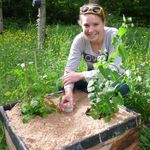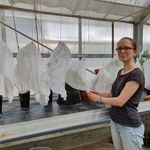BIOLOGICAL CONTROL OF GARLIC MUSTARD - CABI.org
←
→
Page content transcription
If your browser does not render page correctly, please read the page content below
BIOLOGICAL CONTROL OF GARLIC
MUSTARD
Locations Canada, United States
Dates 01/01/1998 - Ongoing
Summary Crushed garlic mustard leaves and seeds smell like cultivated garlic and have
been used as flavouring in cooking for centuries. Garlic mustard is a brassica
from Eurasia that was accidentally taken to North America and became invasive
in many of its forests. Together with partners, CABI is exploring the possibility of
using specially selected and tested insects from the native range in order to
safely control the plant’s spread and impact in the introduced range.The problem Garlic mustard (Alliaria petiolata) is not related to garlic but is a biennial
cruciferous (brassica) plant. Native to Eurasia, it was accidentally introduced to
North America in the 19th century. It is one of the few non-indigenous
herbaceous species that can invade and dominate the understory of North
American forests. It is considered one of the most serious invaders in the
northeastern and midwestern USA and southeastern Canada. Several methods
have been used to control its proliferation in natural areas; hand removal can be
effective in small infestations, while fire, cutting and herbicide treatments have
been used to reduce densities in large infestations. However, these treatments
are costly, need to be repeated over several years and may face regulatory
restrictions.
What we are doing This project to investigate the potential for biological control of the weed was
initiated in 1998 by Prof. Bernd Blossey (Cornell University, USA). A team from
CABI’s centre in Switzerland has been surveying for natural enemies and
assessing host specificity of selected insects.
Biological control is based on the concept that a plant may become invasive
because of the absence of natural enemies that keep it in check in its area of
origin. The project aims to identify and introduce host-specific natural enemies
as biological control agents. A guiding principle is that an agent should not
impact plants other than the target. Risk of non-target damage is assessed by
testing whether a potential agent feeds or develops on other plant species.
By reviewing the literature, we found records of 69 herbivorous insect species
and seven fungi associated with garlic mustard in Europe. 30 species were
collected in subsequent field surveys in Switzerland, Germany, Austria and
Daghestan (Russia) in 1998–2000. Six insects were prioritized as potential
biological control agents: the root-feeding flea beetle Phyllotreta ochripes, the
two shoot-mining weevils Ceutorhynchus alliariae and C. roberti, the two seed-
feeding weevils C. constrictus and C. theonae and the root-crown weevil
C. scrobicollis.
Results so far We have so far discounted three species: the flea beetle P. ochripes and the
stem-mining weevil C. alliariae whichwere not sufficiently specific. The seed-
feeding weevil C. theonae was difficult to find and rear while we suspended work
on the stem-mining weevil C. roberti to concentrate on other species.
Testing in collaboration with the University of Minnesota into the seed-feeding
weevil, C. constrictus, is nearing completion and we are hoping to submit a
petition for release in 2021-2022.
The species selected as the most suitable candidate for release so far is the
root-mining weevil C.scrobicollis. Data from Esther Gerber’s PhD study with
CABI and modelling by Adam Davis (USDA-ARS, Illinois) showed the agent’s
potentially large impact on garlic mustard demography.
In the US, after several attempts to apply for permission to release C.
scrobicollis, it proved specific enough for the USDA-APHIS Technical Advisory
Group (TAG) to recommend it for field release in February 2017. The weevil now
has to pass further US environmental regulations (section 7 consultation with US
Fish and Wildlife Service, tribal and public consultations etc.) before being
permitted for release.
In Canada, a petition to also release C. scrobicollis was submitted in December
2017 and the release permit was granted in June 2018. The first releases took
place in Ontario in mid-August 2018 but establishment could not so far be
confirmed. Weevils are currently being reared in Switzerland and the University
of Toronto for further releases.Donors Agriculture and Agri-Food Canada (AAFC), Lethbridge, Minnesota Invasive
Terrestrial Plants and Pest Center, through the Minnesota Environmental and
Natural Resources Trust Fund, USA, USDA-APHIS-CPHST, Wisconsin
Department of Natural Resources, USA, US Forest Service, Minnesota
Department of Natural Resources, USA, United States Department of Defense,
Strategic Environmental Research Development Program (SERDP)
Partners University of Toronto, Canada, USDA-ARS, University of Minnesota, USA,
Minnesota Department of Natural Resources, USA, Michigan State University,
USA, Cornell University, USA, Colorado State University, USA, Agriculture and
Agri-Food Canada (AAFC), Lethbridge
CABI Project Manager Ghislaine Cortat
https://www.cabi.org/what-we-do/cabi-
projects/You can also read






















































